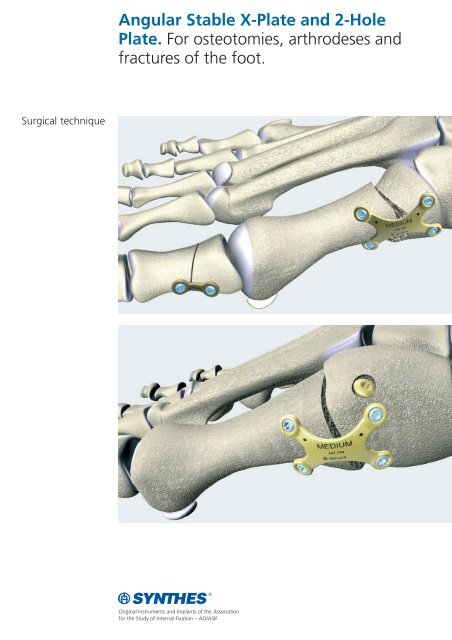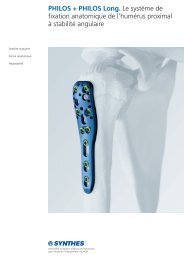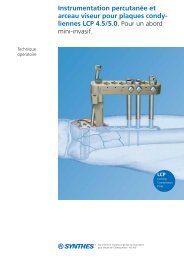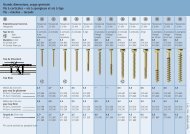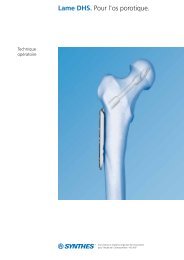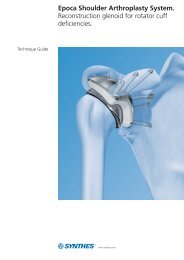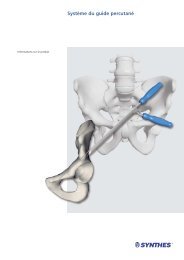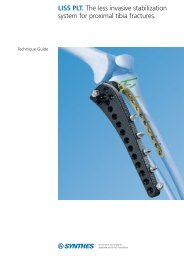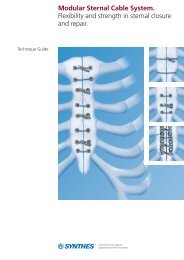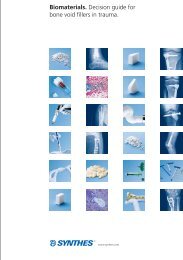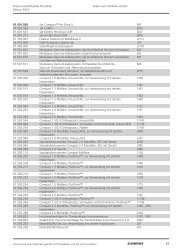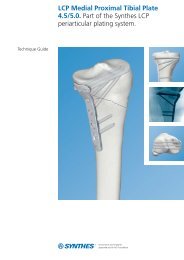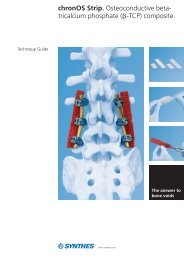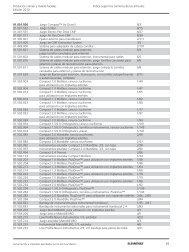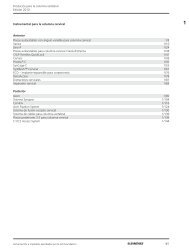Angular Stable X-Plate and 2-Hole Plate. - Synthes
Angular Stable X-Plate and 2-Hole Plate. - Synthes
Angular Stable X-Plate and 2-Hole Plate. - Synthes
You also want an ePaper? Increase the reach of your titles
YUMPU automatically turns print PDFs into web optimized ePapers that Google loves.
Surgical technique<br />
<strong>Angular</strong> <strong>Stable</strong> X-<strong>Plate</strong> <strong>and</strong> 2-<strong>Hole</strong><br />
<strong>Plate</strong>. For osteotomies, arthrodeses <strong>and</strong><br />
fractures of the foot.
Table of Contents<br />
Indications 4<br />
Implants 5<br />
X-plate: Crescentic osteotomy 6<br />
X-plate: MTC arthrodeses 10<br />
2-hole plate: Akin osteotomy 14<br />
Ordering information 16<br />
Bibliography 19<br />
Image intensifier control<br />
Warning<br />
This description is not sufficient for immediate application of<br />
the instrumentation. Instruction by a surgeon experienced<br />
in h<strong>and</strong>ling this instrumentation is highly recommended.<br />
See also the surgical technique for the LCP locking compression<br />
plate (036.000.019).<br />
<strong>Synthes</strong> X-<strong>Plate</strong> <strong>and</strong> 2-<strong>Hole</strong> <strong>Plate</strong> Surgical technique<br />
1
<strong>Angular</strong> <strong>Stable</strong> X-<strong>Plate</strong> <strong>and</strong> 2-<strong>Hole</strong><br />
<strong>Plate</strong>. For osteotomies, arthrodeses <strong>and</strong><br />
fractures of the foot.<br />
System description<br />
The X-plate <strong>and</strong> 2-hole plate have threaded round holes<br />
allowing insertion of 27 mm locking screws (head 2.4 mm)<br />
without the screw heads protruding.<br />
SMALL<br />
The angles of the round threaded holes allow insertion of<br />
a locking screw through an osteotomy or arthrodesis to correspondingly<br />
increase fixation stability.<br />
<strong>Angular</strong> stability<br />
– <strong>Stable</strong> connection between plate <strong>and</strong> screw<br />
2 <strong>Synthes</strong> X-<strong>Plate</strong> <strong>and</strong> 2-<strong>Hole</strong> <strong>Plate</strong> Surgical technique
X-shape<br />
– The plate adapts easily to the anatomy<br />
– Freely selectable screw path<br />
Crescentic saw blade guided by Kirschner wire<br />
– Exact positioning of the osteotomy <strong>and</strong> precise guidance of<br />
the saw using a 1.6 mm Kirschner wire<br />
– Short cutting time<br />
– Minimum shortening of the 1st metatarsal<br />
Greater deflection of two screw holes<br />
– Transversing the osteotomy or arthrodesis with a locking<br />
screw increases stability<br />
3
Indications<br />
X-plate<br />
Arthrodesis<br />
– MTP<br />
– MTC<br />
– Talonavicular<br />
– Calcaneo-Cuboid<br />
Proximal osteotomies<br />
– Crescentic<br />
– Ludloff<br />
– Mau<br />
– Open wedge<br />
– Closing wedge<br />
Calcaneal osteotomies<br />
Fractures<br />
– Single<br />
– Multifragmental<br />
2-hole plate<br />
– Akin osteotomy<br />
4 <strong>Synthes</strong> X-<strong>Plate</strong> <strong>and</strong> 2-<strong>Hole</strong> <strong>Plate</strong> Surgical technique
Implants<br />
X-plate, pure titanium<br />
447.702 X-Locking <strong>Plate</strong> 2.4/2.7, small, 1812 mm,<br />
Pure Titanium<br />
447.704 X-Locking <strong>Plate</strong> 2.4/2.7, medium,<br />
2414 mm, Pure Titanium<br />
447.706 X-Locking <strong>Plate</strong> 2.4/2.7, large, 3014 mm,<br />
Pure Titanium<br />
SMALL<br />
X-plate, stainless steel<br />
247.702 X-Locking <strong>Plate</strong> 2.4/2.7, small, 1812 mm,<br />
Steel<br />
247.704 X-Locking <strong>Plate</strong> 2.4/2.7, medium,<br />
2414 mm, Steel<br />
247.706 X-Locking <strong>Plate</strong> 2.4/2.7, large, 3014 mm,<br />
Steel<br />
SMALL<br />
2-hole plate<br />
447.710 Locking <strong>Plate</strong> 2.4/2.7, straight, 2 holes,<br />
176.01.6 mm, Pure Titanium<br />
247.710 Locking <strong>Plate</strong> 2.4/2.7, straight, 2 holes,<br />
176.01.6 mm, Steel<br />
Locking screws<br />
402.206–260 LCP Locking Screws Stardrive ® Ø 2.7 mm<br />
(head 2.4 mm), self-tapping,<br />
length 6–60 mm, TAN<br />
202.206–260 LCP Locking Screws Stardrive ® Ø 2.7 mm<br />
(head 2.4 mm), self-tapping,<br />
length 6–60 mm, Steel<br />
5
Surgical technique X-plate<br />
Fixation of a crescentic osteotomy<br />
This particular surgical technique is restricted to a crescentic<br />
osteotomy at the base of the 1st metatarsal fixed with an X-<br />
plate. Preoperative planning is not described. The distal soft<br />
tissue release, the removal of the exostosis, <strong>and</strong> the mobilization<br />
of the sesamoid bone are not explained either.<br />
1<br />
Approach to <strong>and</strong> performance of the osteotomy<br />
If the surgeon does not have the specific instruments cited here,<br />
the crescentic osteotomy can also be performed with instruments<br />
of his or her choice.<br />
Required instruments<br />
Oscillating Saw Attachment II Crescentic Technique 532.023<br />
Saw Blade 28180.6 mm, crescentic,<br />
for Oscilliating Saws, sterile<br />
03.000.313S<br />
Saw Blade 2821.90.6 mm, crescentic,<br />
for Oscilliating Saws, sterile<br />
03.000.316S<br />
(a)<br />
The metatarsal I base is approached through a 3-4 cm long<br />
dorsal incision. Expose the extensor hallucis longus <strong>and</strong> the<br />
brevis tendons. Hold the latter medially or laterally to the side.<br />
Identify the metatarsal I/cuneiform I articular cavity with a<br />
Kirschner wire or the image intensifier.<br />
At an angle as close as possible to 120°, insert a 1.6 mm<br />
Kirschner wire into the sagittal plane that runs through the<br />
lengthwise axis of the 1st metatarsal. The distance between the<br />
osteotomy <strong>and</strong> the MTC joint should be 1 cm. (a)<br />
A neutral orientation in the mediolateral plane is desirable.<br />
Medial orientation of the Kirschner wire may lead to the elevation<br />
of the distal metatarsal fragment <strong>and</strong> pronation of the<br />
toe. Conversely, a lateral orientation of the Kirschner wire<br />
may lead to the depression of the distal metatarsal fragment<br />
<strong>and</strong> supination of the toe. (b)<br />
(b)<br />
Insert the Colibri Power Tool with the oscillating saw attachment<br />
over the Kirschner wire. Keep a firm grip on the drilling machine<br />
while performing the osteotomy. (c)<br />
(c)<br />
6 <strong>Synthes</strong> X-<strong>Plate</strong> <strong>and</strong> 2-<strong>Hole</strong> <strong>Plate</strong> Surgical technique
2<br />
Correct the intermetatarsal angle<br />
Position both metatarsal fragments with two bone holding forceps<br />
or two Kirschner wires by pressing the proximal fragment in<br />
a medial direction, <strong>and</strong> the distal fragment in a lateral direction.<br />
Insert a Kirschner wire running from a medial-distal to a proximal<br />
direction to provide temporary fixation.<br />
Note: Do not elevate the distal metatarsal.<br />
7
3<br />
Bend the X-plate<br />
Required instruments<br />
Bending Pin for LCP <strong>Plate</strong>s 2.4 <strong>and</strong> 2.7, with thread 329.922<br />
Universal Bending Pliers, length 165 mm 391.963<br />
With the assistance of 2 bending pins or a forceps <strong>and</strong> one<br />
bending pin, adapt the X-plate to the anatomy.<br />
Note: Only a slight amount of bending is necessary. Repeatedly<br />
bending the plate causes material fatigue <strong>and</strong> must therefore be<br />
avoided.<br />
4<br />
Predrill <strong>and</strong> fix the plate<br />
Required instruments<br />
LCP Drill Sleeve 2.7 (head LCP 2.4), with Scale up to 60 mm 323.061<br />
Drill Bit 2.0 mm, with double marking, length 140/115 mm 323.062<br />
Depth Gauge for Screws 2.7 to 4.0 mm,<br />
measuring range up to 60 mm 319.010<br />
Screwdriver Shaft Stardrive T8, self-holding 314.467<br />
Torque Limiter, 0.8 Nm, with AO/ASIF Quick Coupling 511.776<br />
H<strong>and</strong>le with Quick Coupling, length 110 mm 311.430<br />
The first locking screw is inserted from a distal to proximal direction<br />
through the osteotomy.<br />
Note: The angle of the threaded holes identified with two dots<br />
is stronger to make it easier to insert a locking screw through<br />
the osteotomy.<br />
Screw the LCP drill guide into the plate hole. Predrill the hole<br />
with a 2.0 mm drill with a scale. Read the screw length on the<br />
drill guide scale.<br />
Note: You must use the LCP drill guide for the drill hole <strong>and</strong><br />
plate thread to be aligned on the same axis.<br />
8 <strong>Synthes</strong> X-<strong>Plate</strong> <strong>and</strong> 2-<strong>Hole</strong> <strong>Plate</strong> Surgical technique
Alternatively, determine the screw length with the depth gauge.<br />
Introduce the measured length of the 2.7 mm locking screw<br />
(2.4 mm head). For the screw to lock properly, manually screw in<br />
the last threads using the 0.8 Nm torque limiter.<br />
Insert the other locking screws in the same manner. After predrilling,<br />
always first screw in the locking screw before starting on<br />
the next hole. Remove the Kirschner wire used for temporary<br />
fixation.<br />
9
Surgical technique – X-plate<br />
MTC arthrodesis<br />
The X-plate is for neutralization.<br />
1<br />
Preparing the arthrodesis<br />
Localize the MTC joint with a Kirschner wire or another method.<br />
The approach is through a dorsomedial incision. Prepare the<br />
joint surfaces for internal fixation.<br />
Temporarily fix the joint with a Kirschner wire or clamp.<br />
10 <strong>Synthes</strong> X-<strong>Plate</strong> <strong>and</strong> 2-<strong>Hole</strong> <strong>Plate</strong> Surgical technique
2<br />
Compress<br />
Insert a compression screw from a proximal to distal direction or<br />
visa versa. (Alternatives: from a plantar-distal to proximal-dorsal<br />
direction, or from a plantar-proximal to a distal-dorsal direction).<br />
Remove the temporary fixation.<br />
3<br />
Bend the plate<br />
Required instruments<br />
Bending Pin for LCP <strong>Plate</strong>s 2.4 <strong>and</strong> 2.7, with thread 329.922<br />
Universal Bending Pliers, length 165 mm 391.963<br />
With the assistance of 2 bending pins or a forceps <strong>and</strong> one<br />
bending pin, adapt the X-plate to the anatomy.<br />
Note: Only a slight amount of bending is necessary. Repeatedly<br />
bending the plate causes material fatigue <strong>and</strong> must therefore be<br />
avoided.<br />
11
4<br />
Insert the locking screws<br />
Required instruments<br />
LCP Drill Sleeve 2.7 (head LCP 2.4), with Scale up to 60 mm 323.061<br />
Drill Bit 2.0 mm, with double marking, length 140/115 mm 323.062<br />
Depth Gauge for Screws 2.7 to 4.0 mm,<br />
measuring range up to 60 mm 319.010<br />
Screwdriver Shaft Stardrive T8, self-holding 314.467<br />
Torque Limiter, 0.8 Nm, with AO/ASIF Quick Coupling 511.776<br />
H<strong>and</strong>le with Quick Coupling, length 110 mm 311.430<br />
The locking screws can be inserted in any sequence.<br />
Screw the LCP drill guide into the plate hole. Predrill the hole<br />
with a 2.0 mm drill with a double marking. Read the screw<br />
length on the drill guide scale.<br />
Alternatively, determine the screw length with the depth gauge.<br />
12 <strong>Synthes</strong> X-<strong>Plate</strong> <strong>and</strong> 2-<strong>Hole</strong> <strong>Plate</strong> Surgical technique
Introduce the measured length of the 2.7 mm locking screw<br />
(2.4 mm head). For the screw to lock properly, manually insert<br />
the last threads using the 0.8 Nm torque limiter.<br />
Introduce the other locking screws in the same manner. After<br />
predrilling, always first insert the locking screw before proceeding<br />
to the next hole.<br />
13
Surgical technique 2-hole plate<br />
Fixation of an Akin osteotomy<br />
Preoperative planning is not described.<br />
1<br />
Osteotomy<br />
A medial incision is made. Perform the osteotomy. Retain the<br />
lateral cortex. Stabilize with a Kirschner wire if necessary.<br />
Note: If the lateral cortex is fractured, the osteotomy must be<br />
stabilized with a Kirschner wire.<br />
2<br />
Affix the plate<br />
Required instruments<br />
LCP Drill Sleeve 2.7 (head LCP 2.4), with Scale up to 60 mm 323.061<br />
Drill bit 2.0 mm, with double marking, length 140/115 mm 323.062<br />
Depth Gauge for Screws 2.7 to 4.0 mm,<br />
measuring range up to 60 mm 319.010<br />
Screwdriver Shaft Stardrive T8, self-holding 314.467<br />
Torque Limiter, 0.8 Nm, with AO/ASIF Quick Coupling 511.776<br />
H<strong>and</strong>le with Quick Coupling, length 110 mm 311.430<br />
In most cases, this plate does not have to be bent.<br />
Screw the LCP drill guide into the plate hole. Predrill the hole<br />
with a 2.0 mm drill with a scale. Read the screw length on the<br />
drill guide scale. Alternatively, determine the screw length with<br />
the depth gauge.<br />
Note: You must use the LCP drill guide for the drill hole <strong>and</strong><br />
plate thread to be aligned on the same axis.<br />
Introduce the measured length of the 2.7 mm locking screw<br />
(2.4 mm head). For the screw to lock properly, manually insert<br />
the last threads using the 0.8 Nm torque limiter.<br />
Use the same procedure for the second locking screw.<br />
14 <strong>Synthes</strong> X-<strong>Plate</strong> <strong>and</strong> 2-<strong>Hole</strong> <strong>Plate</strong> Surgical technique
3<br />
After internal fixation<br />
If a Kirschner wire was used, remove it now.<br />
Note: If the lateral cortex is fractured, leave the Kirschner wire<br />
in place.<br />
15
Ordering information<br />
01.282.104 Compact Foot X-Locking <strong>Plate</strong> 2.4/2.7 <strong>and</strong> Locking <strong>Plate</strong> 2.4/2.7,<br />
straight (2 holes), Pure Titanium<br />
682.730 Module Compact Foot X-Lock. <strong>Plate</strong> 2.4/2.7 <strong>and</strong> Locking <strong>Plate</strong><br />
2.4/2.7, straight (2 holes), with Lid, without Contents 1<br />
Implants<br />
447.702 X-Locking <strong>Plate</strong> 2.4/2.7, small, 1812 mm, Pure Titanium 2<br />
447.704 X-Locking <strong>Plate</strong> 2.4/2.7, medium, 2414 mm, Pure Titanium 2<br />
447.706 X-Locking <strong>Plate</strong> 2.4/2.7, large, 3014 mm, Pure Titanium 2<br />
447.710 Locking <strong>Plate</strong> 2.4/2.7, straight, 2 holes,<br />
176.01.6 mm, Pure Titanium 6<br />
Instruments<br />
312.240 Double Drill Guide 2.7/2.0 1<br />
329.922 Bending Pin for LCP <strong>Plate</strong>s 2.4 <strong>and</strong> 2.7, with thread 2<br />
323.061 LCP Drill Sleeve 2.7 (head LCP 2.4), with Scale up to 60 mm,<br />
for Drill Bits 2.0 mm 1<br />
310.870 Countersink 2.7, length 62 mm 1<br />
323.062 Drill Bit 2.0 mm, with double marking, length 140/115 mm,<br />
3-flute, for Quick Coupling 1<br />
314.467 Screwdriver Shaft, Stardrive ® , T8, self-holding 1<br />
Optional<br />
310.163 Drill Bit 2.0 mm, with marking, length 110/95 mm,<br />
2-flute, for Jacobs Chuck<br />
310.200 Drill Bit 2.0 mm, length 85/70 mm, 2-flute, for Jacobs Chuck<br />
310.260 Drill Bit 2.7 mm, length 100/75 mm, 2-flute, for Quick Coupling<br />
310.270 Drill Bit 2.7 mm, length 85/70 mm, 2-flute, for Jacobs Chuck<br />
310.280 Drill Bit 2.7 mm, length 125/100 mm, 2-flute, for Quick Coupling<br />
310.534 Drill Bit 2.0 mm, with marking, length 110/85 mm,<br />
2-flute, for Quick Coupling<br />
313.303 Screwdriver Shaft, Stardrive ® , T8, cylinder, with groove,<br />
shaft 3.5 mm, for Mini Quick Coupling<br />
313.304 Screwdriver Shaft, Stardrive ® , T8, cylinder, with groove,<br />
shaft 3.5 mm, for AO/ASIF Quick Coupling<br />
314.039 Screwdriver Shaft, Stardrive ® , T8, self-holding<br />
347.981 Holding Forceps for <strong>Plate</strong>s 1.0 to 2.4<br />
01.282.102 Compact Foot X-Locking <strong>Plate</strong> 2.4/2.7 <strong>and</strong> Locking <strong>Plate</strong> 2.4/2.7,<br />
straight (2 holes), Steel<br />
682.730 Module Compact Foot X-Lock. <strong>Plate</strong> 2.4/2.7 <strong>and</strong> Locking <strong>Plate</strong><br />
2.4/2.7, straight (2 holes), with Lid, without Contents 1<br />
Implants<br />
247.702 X-Locking <strong>Plate</strong> 2.4/2.7, small, 1812 mm, Steel 2<br />
247.704 X-Locking <strong>Plate</strong> 2.4/2.7, medium, 2414 mm, Steel 2<br />
247.706 X-Locking <strong>Plate</strong> 2.4/2.7, large, 3014 mm, Steel 2<br />
247.710 Locking <strong>Plate</strong> 2.4/2.7, straight, 2 holes,<br />
176.01.6 mm, Steel 6<br />
Instruments<br />
312.240 Double Drill Guide 2.7/2.0 1<br />
329.922 Bending Pin for LCP <strong>Plate</strong>s 2.4 <strong>and</strong> 2.7, with thread 2<br />
323.061 LCP Drill Sleeve 2.7 (head LCP 2.4), with Scale up to 60 mm,<br />
for Drill Bits 2.0 mm 1<br />
310.870 Countersink 2.7, length 62 mm 1<br />
323.062 Drill Bit 2.0 mm, with double marking, length 140/115 mm,<br />
3-flute, for Quick Coupling 1<br />
314.467 Screwdriver Shaft, Stardrive ® , T8, self-holding 1<br />
Optional<br />
310.163 Drill Bit 2.0 mm, with marking, length 110/95 mm,<br />
2-flute, for Jacobs Chuck<br />
310.200 Drill Bit 2.0 mm, length 85/70 mm, 2-flute, for Jacobs Chuck<br />
310.260 Drill Bit 2.7 mm, length 100/75 mm, 2-flute, for Quick Coupling<br />
310.270 Drill Bit 2.7 mm, length 85/70 mm, 2-flute, for Jacobs Chuck<br />
310.280 Drill Bit 2.7 mm, length 125/100 mm, 2-flute, for Quick Coupling<br />
310.534 Drill Bit 2.0 mm, with marking, length 110/85 mm,<br />
2-flute, for Quick Coupling<br />
313.303 Screwdriver Shaft, Stardrive ® , T8, cylinder, with groove,<br />
shaft 3.5 mm, for Mini Quick Coupling<br />
313.304 Screwdriver Shaft, Stardrive ® , T8, cylinder, with groove,<br />
shaft 3.5 mm, for AO/ASIF Quick Coupling<br />
314.039 Screwdriver Shaft, Stardrive ® , T8, self-holding<br />
347.981 Holding Forceps for <strong>Plate</strong>s 1.0 to 2.4<br />
16 <strong>Synthes</strong> X-<strong>Plate</strong> <strong>and</strong> 2-<strong>Hole</strong> <strong>Plate</strong> Surgical technique
01.282.004 LCP Compact Foot Basic Instrument Set <strong>and</strong> Screws 2.7 mm,<br />
Titanium<br />
682.733 Insert, size 1/2, Compact Foot Instruments (Basic Instrument Set) 1<br />
391.962 Bending/Cutting Pliers 1<br />
391.963 Universal Bending Pliers, length 165 mm 2<br />
319.005 Depth Gauge for Screws 2.0 <strong>and</strong> 2.4 mm,<br />
measuring range up to 40 mm 1<br />
319.010 Depth Gauge for Screws 2.7 to 4.0 mm,<br />
measuring range up to 60 mm 1<br />
311.012 H<strong>and</strong>le, medium, with Mini Quick Coupling 1<br />
311.430 H<strong>and</strong>le with Quick Coupling, length 110 mm 1<br />
682.735 Rack for LCP Locking Screws 2.7 mm (head LCP 2.4) 1<br />
682.736 Rack for Cortex Screws 2.7 mm 1<br />
511.776 Torque Limiter, 0.8 Nm, with AO/ASIF Quick Coupling 1<br />
511.777 Torque Limiter, 0.4 Nm, with AO/ASIF Quick Coupling 1<br />
402.210– LCP Locking Screw Stardrive ® 2.7 mm (head LCP 2.4),<br />
402.240 self-tapping, length 10–40 mm, TAN 3<br />
402.242– LCP Locking Screw Stardrive ® 2.7 mm (head LCP 2.4),<br />
402.260 self-tapping, length 42–60 mm, TAN 2<br />
402.870– Cortex Screw Stardrive ® 2.7 mm, self-tapping,<br />
402.900 length 10–40 mm, TAN 3<br />
402.964– Cortex Screw Stardrive ® 2.7 mm, self-tapping,<br />
402.969 length 45–60 mm, TAN 2<br />
Optional<br />
313.300 Combined Holding Sleeve for<br />
Cortex Screws Stardrive ® 2.4/2.7 mm, T8<br />
313.301 Holding Sleeve for<br />
LCP Screws Stardrive ® 2.4/2.7 mm (head LCP 2.4), T8<br />
03.100.000 H<strong>and</strong>le, lockable, with Mini Quick Coupling<br />
314.121 X-ray symbol Stardrive ® 50 mm, thickness 0.5 mm, steel<br />
402.206 LCP Locking Screw Stardrive ® 2.7 mm (head LCP 2.4),<br />
self-tapping, length 6 mm, TAN<br />
402.208 LCP Locking Screw Stardrive ® 2.7 mm (head LCP 2.4),<br />
self-tapping, length 8 mm, TAN<br />
Accessories for the Colibri machine system (532.001)<br />
532.023 Oscillating Saw Attachment II Crescentic Technique<br />
03.000.313S Saw Blade 28180.6 mm, crescentic, for Oscilliating Saws, sterile<br />
03.000.316S Saw Blade 2821.90.6 mm, crescentic,<br />
for Oscilliating Saws, sterile<br />
01.282.002 LCP Compact Foot Basic Instrument Set <strong>and</strong> Screws Ø 2.7 mm,<br />
Steel<br />
682.733 Insert, size 1/2, Compact Foot Instruments (Basic Instrument Set) 1<br />
391.962 Bending/Cutting Pliers 1<br />
391.963 Universal Bending Pliers, length 165 mm 2<br />
319.005 Depth Gauge for Screws 2.0 <strong>and</strong> 2.4 mm,<br />
measuring range up to 40 mm 1<br />
319.010 Depth Gauge for Screws 2.7 to 4.0 mm,<br />
measuring range up to 60 mm 1<br />
311.012 H<strong>and</strong>le, medium, with Mini Quick Coupling 1<br />
311.430 H<strong>and</strong>le with Quick Coupling, length 110 mm 1<br />
682.735 Rack for LCP Locking Screws 2.7 mm (head LCP 2.4) 1<br />
682.736 Rack for Cortex Screws 2.7 mm 1<br />
511.776 Torque Limiter, 0.8 Nm, with AO/ASIF Quick Coupling 1<br />
511.777 Torque Limiter, 0.4 Nm, with AO/ASIF Quick Coupling 1<br />
202.210– LCP Locking Screw Stardrive ® 2.7 mm (head LCP 2.4),<br />
202.240 self-tapping, length 10–40 mm, Steel 3<br />
202.242– LCP Locking Screw Stardrive ® 2.7 mm (head LCP 2.4),<br />
202.260 self-tapping, length 42–60 mm, Steel 2<br />
202.870– Cortex Screw Stardrive ® 2.7 mm, self-tapping,<br />
202.900 length 10–40 mm, Steel 3<br />
202.964– Cortex Screw Stardrive ® 2.7 mm, self-tapping,<br />
202.969 length 45–60 mm, Steel 2<br />
Optional<br />
313.300 Combined Holding Sleeve for<br />
Cortex Screws Stardrive ® 2.4/2.7 mm, T8<br />
313.301 Holding Sleeve for<br />
LCP Screws Stardrive ® 2.4/2.7 mm (head LCP 2.4), T8<br />
03.100.000 H<strong>and</strong>le, lockable, with Mini Quick Coupling<br />
314.121 X-ray symbol Stardrive ® 50 mm, thickness 0.5 mm, steel<br />
202.206 LCP Locking Screw Stardrive ® 2.7 mm (head LCP 2.4),<br />
self-tapping, length 6 mm, Steel<br />
202.208 LCP Locking Screw Stardrive ® 2.7 mm (head LCP 2.4),<br />
self-tapping, length 8 mm, Steel<br />
Vario Cases<br />
689.507 Lid (stainless steel), size 1/1, for Vario Case <br />
689.509 Vario Case , Framing, size 1/1, height 67 mm<br />
689.516 Vario Case , Framing, size 1/2, height 126 mm<br />
689.537 Lid (Stainless Steel), size 1/2, for Vario Case <br />
682.640 Insert, size 1/4, for Additional Instruments<br />
Vario Cases have space for:<br />
LCP Compact Foot Basic Instrument Set (Art. No. 01.282.004 or 01.282.002)<br />
3 Implant Modules + 1 Insert, size 1/4,<br />
for Additional Instruments (Art. No. 682.640)<br />
LCP Compact Foot Basic Instrument Set (Art. No. 01.282.004 or 01.282.002) <strong>and</strong><br />
4 implant modules.<br />
17
18 <strong>Synthes</strong> X-<strong>Plate</strong> <strong>and</strong> 2-<strong>Hole</strong> <strong>Plate</strong> Surgical technique
Bibliography<br />
Osteotomies of the First Metatarsal<br />
Coughlin, MJ, Boise, Idaho, (1996) Instructional Course Lectures,<br />
The American Academy of Orthopaedic Surgeons-Hallux Valgus;<br />
J Bone Joint Surg 78-A:932–66<br />
Trnka HJ, Parks BG, Ivanic G, Chu IT, KG, Easley ME, Schon LC,<br />
Myerson MS (2000) Six First Metatarsal Shaft Osteotomies,<br />
Mechanical <strong>and</strong> Immobilization Comparisons. Clin Orthop Relat<br />
Res 381:256-265<br />
Akin osteotomy<br />
Frey C, Jahss M, Kummer FJ (1991) The Akin procedure: an<br />
analysis of results. Foot Ankle 12(1):1–6<br />
Proximal Metatarsal Osteotomy<br />
Coughlin MJ (2002), Proximal First Metatarsal Osteotomy. In:<br />
Harold B. Kitaoka (editor) The Foot <strong>and</strong> Ankle, ed 2. In Series:<br />
Thompson RC (editors) Master Techniques in Orthopaedic<br />
Surgery. Lippincott Williams & Wilkins:71–98<br />
Jones C, Coughlin M, Villadot R, M.D., Golanó P (2005) Proximal<br />
crescentic metatarsal osteotomy: the effect of saw blade<br />
orientation on first ray elevation. Foot Ankle Int. 26(2):152–7<br />
Roger A. Mann (1998), Hallux valgus: Soft Tissue Procedure with<br />
Proximal Metatarsal Osteotomy. In: Nikolaus Wülker, Michael<br />
Stephens, Andrea Cracchiolo (editors). An Atlas of Foot <strong>and</strong><br />
Ankle Surgery. Martin Dunitz, 19–27<br />
Veri JP, Pirani SP, Claridge R (2001) Crescentic Proximal Metatarsal<br />
Osteotomy for Moderate to Severe Hallux Valgus: A Mean<br />
12.2 Year Follow-Up Study. Foot Ankle Int 22 (10):817–22<br />
Mann RA, M.D., Rudicel S, Graves SC, Oakl<strong>and</strong>, California<br />
(1992) Repair of Hallux Valgus with a Distal Soft-Tissue Procedure<br />
<strong>and</strong> Proximal Metatarsal Osteotomy. J Bone Joint Surg<br />
74-A(1):124–129<br />
Zettl R, Trnka HJ, Easley M, Salzer M, Ritschl P (2000) Moderate<br />
to severe hallux valgus deformity: correction with proximal<br />
crescentic osteotomy <strong>and</strong> distal soft-tissue release. Arch Orthop<br />
Trauma Surg 120:397–402<br />
Arthrodeses<br />
Hofbauer MH, Grossman JP (1996) The Lapidus procedure. Clin<br />
Podiatr Med Surg 13(3):485–96<br />
19
20 <strong>Synthes</strong> X-<strong>Plate</strong> <strong>and</strong> 2-<strong>Hole</strong> <strong>Plate</strong> Surgical technique
Presented by:<br />
0123<br />
036.000.907 SE_019740 AA © <strong>Synthes</strong> 2005 Printed in Switzerl<strong>and</strong> LAG Subject to modifications.


